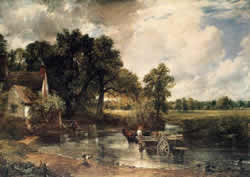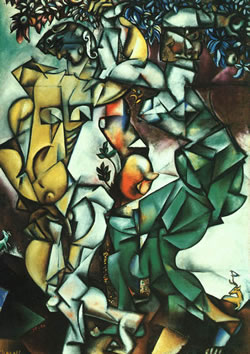John Constable
Claude Monet
Vincent Van Gogh
Marc Chagall
Pablo Picasso
Although he showed an early talent for art and began painting his native Suffolk scenery before he left school, his great originality matured slowly.

He committed himself to a career as an artist only in 1799, when he joined the Royal Academy Schools and it was not until 1829 that he was grudgingly made a full Academician, elected by a majority of only one vote.
In 1816 he became financially secure on the death of his father and married Maria Bicknell after a seven-year courtship and in the fact of strong opposition from her family. During the 1820s he began to win recognition: The Hay Wain (National Gallery, London, 1821) won a gold medal at the Paris Salon of 1824 and Constable was admired by Delacroix and Bonington among others.
His wife died in 1828, however, and the remaining years of his life were clouded by despondency.
This text is an excerpt from The WebMuseum, Paris
His youth was spent in Le Havre, where he first excelled as a caricaturist but was then converted to landscape painting by his early mentor Boudin, from whom he derived his firm predilection for painting out of doors.

In 1859 he studied in Paris at the Atelier Suisse and formed a friendship with Pissarro. After two years' military service in Algiers, he returned to Le Havre and met Jongkind, to whom he said he owed `the definitive education of my eye'.
He then, in 1862, entered the studio of Gleyre in Paris and there met Renoir, Sisley, and Bazille, with whom he was to form the nucleus of the Impressionist group.
Monet's devotion to painting out of doors is illustrated by the famous story concerning one of his most ambitious early works, Women in the Garden (Musée d'Orsay, Paris; 1866-67). The picture is about 2.5 meters high and to enable him to paint all of it outside he had a trench dug in the garden so that the canvas could be raised or lowered by pulleys to the height he required.
Courbet visited him when he was working on it and said Monet would not paint even the leaves in the background unless the lighting conditions were exactly right.
This text is an excerpt from The WebMuseum, Paris
Gogh, Vincent (Willem) van (b. March 30, 1853, Zundert, Neth.--d. July 29, 1890, Auvers-sur-Oise, near Paris), generally considered the greatest Dutch painter and draughtsman after Rembrandt.

With Cézanne and Gauguin the greatest of Post-Impressionist artists. He powerfully influenced the current of Expressionism in modern art. His work, all of it produced during a period of only 10 years, hauntingly conveys through its striking colour, coarse brushwork, and contoured forms the anguish of a mental illness that eventually resulted in suicide. Among his masterpieces are numerous self-portraits and the well-known The Starry Night (1889).
This text is an excerpt from The WebMuseum, Paris

Russian-born French painter. Born to a humble Jewish family in the ghetto of a large town in White Russia, Chagall passed a childhood steeped in Hasidic culture.
Very early in life he was encouraged by his mother to follow his vocation and she managed to get him into a St Petersburg art school. Returning to Vitebsk, he became engaged to Bella Rosenfeld (whom he married twelve years later), then, in 1910, set off for Paris, 'the Mecca of art'.
He was a tenant at La Ruche, where he had Modigliani and Soutine for neighbours. His Slav Expressionism was tinged with the influence of Daumier, Jean-François Millet, the Nabis and the Fauves.
He was also influenced by Cubism. Essentially a colourist, Chagall was interested in the Simultaneist vision of Robert Delaunay and the Luminists of the Section d'Or.

Pablo Picasso, born in Spain, was a child prodigy who was recognized as such by his art-teacher father, who ably led him along.
The small Museo de Picasso in Barcelona is devoted primarily to his early works, which include strikingly realistic renderings of casts of ancient sculpture.
He was a rebel from the start and, as a teenager, began to frequent the Barcelona cafes where intellectuals gathered.
He soon went to Paris, the capital of art, and soaked up the works of Manet, Gustave Courbet, and Toulouse-Lautrec, whose sketchy style impressed him greatly. Then it was back to Spain, a return to France, and again back to Spain - all in the years 1899 to 1904.
....




